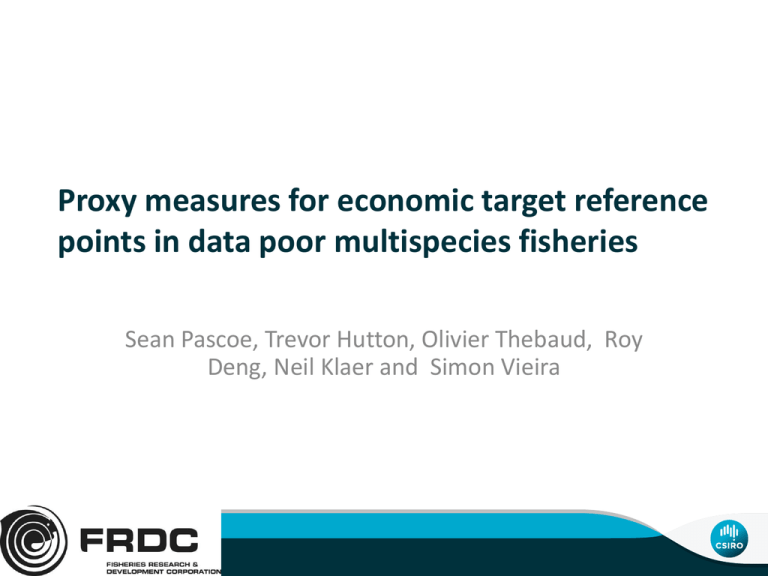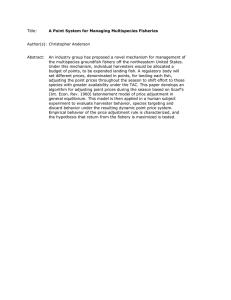Proxy measures for economic target reference
advertisement

Proxy measures for economic target reference points in data poor multispecies fisheries Sean Pascoe, Trevor Hutton, Olivier Thebaud, Roy Deng, Neil Klaer and Simon Vieira 1 Outline • Policy background • Australian Commonwealth Fisheries Harvest Strategy and Policy • Data poor fisheries (more common that you would think) • The theory • Developing “rules of thumb” • Use of generic bioeconomic models • How good are the “rules of thumb” • Conclusions 2 Policy background • Objective of maximise net economic returns from the fishery • Policy requires each managed species to have an economic target reference point i.e. BMEY • Relatively easy to determine MEY for single species fisheries • More complicated for multispecies fisheries • Requires comprehensive bioeconomic model • Stocks of many “less important” species are not regularly assessed • Development of bioeconomic models not possible without the biology • Not able to identify/estimate BMEY • Default in the Commonwealth Harvest Strategy and Policy is: BMEY = 1.2BMSY • Aim of this study is to see if we could do better. 3 The theory … and reality Some species being well above BMSY Some species being well below BMSY Some species being around BMSY Some species becoming extinct • A set of single species based BMEY TRF would not be feasible • Without a “real” bioeconomic model of the fishery, need some other way to derive estimates of where we want to be for each species Revenue, costs • • • • 20 15 Species 1 Species 2 Species 3 10 Species 4 cost 5 0 0 5 10 15 25 40 35 revenue 30 profit cost 25 20 15 10 5 0 0 5 10 15 Effort 4 20 Effort Revenue, profit, costs • Maximising economic profits in a multispecies fishery may result in 25 20 25 Development of a “generic” bioeconomic model • Two underlying biological models (surplus production) • Schaefer and Fox • Joint production (only one fishing effort) • Objective function: maximise total economic profits in the fishery • Randomly varied • Number of species: 2 to 20 • Prices and cost per unit effort (based on South East fishery as a base for orders of magnitude) • q, k and r (again, based around parameters for South East fishery) – Dropped “unrealistic” combinations 5 Stochastic simulations • Ran the models 20,000 times • Estimated the ratio BMEY/BMSY for each species • Default proxy generally low • wide dispersion • Fairly invariant to number of species in the simulation 6 Developing “rules of thumb” • Two approaches • Regression tree • Bayesian Network • Initial regression model to identify key parameters Intercept Species characteristic Revenue share p (price) r (growth rate) q (catchability) K (unexploited biomass) Fishery characteristic c (cost) Distance Diagnostics 7 N.Obs 2 R Scaled Beta Rank Estimate Std. Error t value 1.823 0.004 446.740 *** 1.389 1.012 -0.022 1.658 -25.010 0.000 0.008 0.000 0.005 0.035 0.000 127.370 -60.720 341.610 -720.200 -105.810 *** *** *** *** *** 0.098 -0.031 0.184 -0.359 -0.065 3 5 2 1 4 0.000 -0.189 0.000 0.006 39.770 -32.640 *** *** 0.018 -0.016 6 7 227,181 0.767 Regression tree • Split by revenue share • • • • <5% 5-10% 10-20% >20% • Key determinants • Relative catchability (q) • Relative growth (r) 8 Performance • Applied only to the “main” species • Similar distribution to optimal “real” distribution • Default proxy (1.2BMSY) performs reasonably well also, but some big losses 9 Bayesian Network • BN relationships derived from the model output Growth rate (r) Low Below average Average Above average High Price below average Average Above average High 13.4 27.0 27.1 32.5 3 ± 1.4 BMEY/BMSY ratio 3.65 ± 1.3 Revenue share Number of species caught 3 to 9 9 to 13 13 to 16 16 to 18 18 to 20 15.9 21.4 21.4 16.9 24.3 20.0 20.0 20.0 20.0 20.0 Less than 5 percent Five to 10 percent Ten to 20 percent Greater than 20 percent 45.1 24.5 20.2 10.1 1.95 ± 1 0 to 0.7 0.7 to 0.99 0.99 to 1.18 1.18 to 1.33 1.33 to 1.46 1.46 to 1.58 1.58 to 1.69 1.69 to 1.8 1.8 to 1.9 1.9 to 2 10.3 10.6 9.90 9.83 9.91 10.3 10.3 10.7 9.75 8.35 Catchability (q) Low Below average Average Above average High 20.0 20.0 20.0 20.0 20.0 3 ± 1.4 1.35 ± 0.48 13.9 ± 4.6 Fishing costs Low Below average Average Above average High 20.0 20.0 20.0 20.0 20.0 3 ± 1.4 10 Carrying capacity (K) Low Medium High 33.0 33.0 34.0 2.01 ± 0.82 Comparison model • Bioeconomic model of the south east trawl fishery • 6 metiers (4 otter trawl, 2 Danish seine) • 13 species • Fox equilibrium model and dynamic model (100 years) 11 Static vs dynamic MEY 40000 Equilibrium Dynamic 35000 30000 Biomass (tonnes) Very little difference • 5% discount rate • Flathead >20% of revenue 25000 20000 15000 10000 5000 12 Whiting Silver Trevally Silver Warehou Ribaldo Ocean Perch Morwong West Morwong East Mirror Dory Ling John Dory Gemfish Flathead Blue Warehou 0 Comparison of results 3 BBN 2.5 Tree Linear (BBN) Tree/BBN value 2 Linear (Tree) 1.5 1 0.5 0 0 13 0.5 1 1.5 2 Bioeconomic model value 2.5 3 Imposing the targets on the fishery • Goal programming model • Objective to minimise the total divergence from – the individuals TRP weighted by revenue share and overall 60% weight – The optimal average fishery profits 40% weight • Average TRPs from bioeconomic model • Compared final stock status with optimal status • 1000 runs 14 Impact on fleet profits • Rules of thumb generally performed as well as a “proper” bioeconomic model • Default proxy appears to perform better, but artefact that it essentially abandoned attempting to achieve the set of TRPs imposed (which were unachievable) and just maximised the profit component 15 Summary • Rules of thumb approaches can provide reasonably good estimates of economic target reference points with limited information • Even “good” bioeconomic models are not perfect • The current proxy default TRP (BMEY=1.2BMSY) is not achievable in multispecies fisheries • There still is an issue as to how many and which species should have TRPs in a multispecies fishery • Too many may cause more problems than it solves • With (perfect) joint product, just one for the main species seems to result in good outcomes 16


